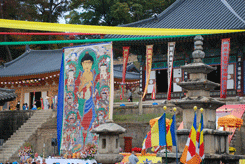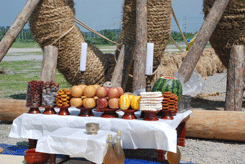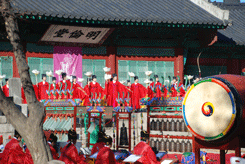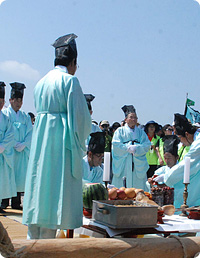Ceremony
 |
 |
 |
Lunar calendar
The Gregorian calendar has been the official calendar since 1895. However, lunar calendar is still used for reckoning the dates of traditional festivals, and many people still celebrate their birthday by it. The first day of each month is the new moon, and the fifteenth day is the full moon. Some months are thirty days and some twenty nine. As the twelve months do not equal to a solar year, an extra month, called Yundal in Korea, is interposed every three years. The extra month is interposed between any two months from the second to the eleventh in a way that only one of the twenty four solar terms will fall in the intercalary month; however, the vernal equinox must fall in the second month, the summer solstice in the fifth month, the autumn equinox in the eight month, and the winter solstice in the eleventh month. Each year is named according to the combination of two sets of Chinese characters. One set, the Celestial Stems has ten basic characters and the other set, the terrestrial Branches have twelve, which symbolize the twelve animals of the zodiac. The traditional way to ask a person's age is to ask his or her zodiacal animal, or Tti in Korean. The twelve animals are also used to divide the day into twelve two-hour periods. The days of the week are named for the sun, the moon, and the planets Mars, Mercury, Jupiter, Venus and Saturn. The ancient Chinese named the planets for the Five Elements, Fire, Water, Wood, Metal and Earth-and it is by these names they are known today. The zodiac animals are in the order of rat, ox, tiger, rabbit, dragon, snake, horse, sheep, monkey, cock, dog and pig.
Seolnal
Celebrated on the first day of the first month of the lunar calendar is Seolnal, a day for families to get together to remember their roots and renew close family ties. The family gathers at the eldest son's home and men from the eldest down to the little boys, pay homage to their ancestors in solemn rites called Charye. After the rites, formal New Year's obeisance called Sebae is made with deep bows to the elders of the family in the order of grandparents, parents, uncles and aunts. Also people go around the village or neighborhood making deep bows to relatives and village elders. It is customary for those who receive Sebae to reciprocate in some way. Children are usually given a New Year's gift in money, from the family elders at which time it is referred to as Sebaetton and told to study hard, to obey their parents, or some other appropriate remarks. Tteokkuk, a rice-dumpling soup and a symbol of gaining an age, is traditionally eaten on Seolnal. Kite-flying, playing a backgammon-like game called Yut and a jumping teeter-totter are favorite pastime of the day.
Traditionally people dress in new clothes specifically prepared for Seolnal as a symbol of beginning life afresh. The clothes were called seolbim. It was customary to take all kinds of measures to ward off evil spirits and to bring good fortune. A Bokjori is bought and hung on a wall between midnight of the last day of the year and the dawn of New Year's Day.
It is a lucky ladle or Bokjori, a bamboo-woven strainer or ladle, which
traditionally have been used for washing and handling rice and grains. Their association with rice, a bountiful harvest, and good fortune, has made these ladles a symbol of good luck for the Lunar New Year. These New Year's good-luck ladles were customarily sold late at night on New Year's Eve by door-to-door peddlers, hawking in the darkness. The Korean letter Bok which literally means good fortune is written on it for the celebration of the day. A dipper will bring the family good luck in the New Year if brought at this time and hung on the wall of a room, hall or a kitchen. The day comes in January or February by the solar calendar.
Buddha's birthday
The eighth day of the fourth lunar month is Buddha's birthday. It is called Chopail, literally meaning eighth day of the month and also Bucheonim Osinnal, literally meaning the day Buddha came. This day has been a legal holiday in Korea since 1975. Buddhists celebrate this day with many events and much merrymaking. Among them are a symbolic bathing of the baby Buddha which stands in a lotus-shaped basin. This ritual is not limited to monks but can be done by anyone who so desires. Another ritual in which laymen can participate is called Tapdori. A group of Buddhists led by a monk form a ring and circle a Tap, or pagoda, praying and chanting sutras. The highlight of the day is the lighting of paper lanterns, which are hung for each member of the family. These are usually purchased in advance from the resident monks who hang them and chant prayers for the subscribers through the day. The lanterns are lit in the evening. To the Buddhist, the lantern symbolizes wisdom and mercy. The lantern are said to brighten and eliminate the dark spots in one's heart as the light is believed to be given by the Buddha. The lanterns are made of paper or plastic, but in olden times they were made of silk or paper. They come in a variety of shapes including octagonal, lotus flower, phoenix, carp, cloud, drum and turtle. In some towns and cities, the lanterns are carried in a parade, which may include elaborate floats. The day often falls in early May by solar calendar.
Ritual ceremony (Jesa)
Jesa is the Confucian rituals or ceremonies through which Koreans pay homage to their ancestors. The rites are an integral part of the Korean ethics, which emphasizes a vertical order from the eldest down to the youngest. Jesa ritual includes basically three types ; Gije which is performed at midnight on the eve of the ancestor's death day, Charye which is performed in the morning on certain holidays locally called Myeongjol, while Myoje is performed at the grave. The ritual is traditionally performed by men, while women prepare the food and necessary arrangements. The Gije and Charye involve the offering of food and drinks to the ancestors. The ritual table is arranged in front of the folding screen and portrait of the deceased is placed on the table or the spirit paper is posted on the screen wall. The ritual begins with burning incense and offering a cup of wine to the spirit of the ancestor usually by the first son of the deceased.
After he rotates the cup of wine three times over the burning incense and its smoke, he bows three times with his two assistant younger brothers or family relatives. While wine is offered by ritual performers, the helper moves chopsticks and spoon on the plates and dishes, and pours the wine for the performers in accordance with the ritual order. Offering wine varies family to family but offers three cups of wine or more. Once wine offering is completed, the spoon is placed in the rice bowl and the men leave the room or turn their backs to let the ancestor feast at will. After a couple of minutes, the ritual performers bow three times again to conclude the ritual. Then, the rest of the families and relatives bow to the spirit of the ancestor, and food is shared by the families. Gije is now performed early evening hours for the convenience of the family. The process is almost the same as those of other ritual services. But only a deceased or ancestral couple is honored in the Gije, while Charye honors all ancestors for four generations back. Myoje, or grave-side rituals, are simpler than Gije and Charye rites is a wooden ancestor tablet called Sinju or Wipae or a disposable paper called Jibang. Most families today use the latter black ink on the paper and it is attached to the wall or to a folding screen behind. The paper is burned at the end of the rite.
Chuseok
The fifteenth day of the eighth month is Chuseok, the Harvest Moon Festival, a time of thanksgiving. Also is called Jungchujeol, meaning mid-autumn day, and Hangawi. Chuseok is believed to have originated in the first century in Silla. A month long weaving festival was held in the capital, today's Gyeongju. Regardless of origin, Chuseok and its related customs are undeniably important to Koreans. And when Chuseok dawns, they put on their best outfits and, like generations before them, begin a series of rituals and activities culminating in gazing at the full moon. The day begins with paying homage to the ancestors with a feast made from the new harvest. It is offered in solemn rites called Charye. On Chuseok, it is customary to visit the graves of one's ancestor's to pay respect with bows and food offerings. It is also a time to cut the grass and pull out weeds around the grave. There are number of games and dances associated with Chuseok, which, in the past, helped to strengthen neighborly relations and to promote community spirit. Among the most notable is the tortoise game and Ganggang Suwollae, one type of traditional dance, where ten to twenty women gather together and form a circle and sing songs together, basically having a good time. The day comes in September or October by Gregorian calendar. For many Koreans, a long and hurried exodus to their hometowns to be with family and friends as do for Seolnal.
Rite for Confucius (Seokcheon)
Seokcheon literally means to dispense libations, and is a rite performed at the temple of Confucius. Food and drinks are offered before the images, portraits or spirit tablets of Confucius and the other sages in the shrine. It is performed twice a year. The basic idea of the Seokcheon ritual is to have the participants reaffirm the principles of morality of personal, familial and state affairs and emulate filial piety, virtue, loyalty, honor, social harmony and faith. The idea is also to foster and practice the ideological and spiritual values of Confucianism. In ancient times, the rites started in the wee hours of the morning with drumming and other musical performances and great pageant gradually unfolded in prescribed stage. Incense was burned, wine and food offerings were made, stately dances were performed, and invocations and addresses, interspersed with classical court music, were rendered.
Rites for Household (Gosa)
Gosa refers to the simple shamanistic rituals that are performed to secure the good offices of the household gods. It is believed that the household gods are discrete for each household and reside everywhere inside and outside the house including its structure. There are Foundation God, Door Guard, House Lord, Kitchen God, Birth Grandmother, Toilet Maid, Mountain God, Seven Star Spirit on the terrace where crocks of foodstuffs are stored, and Five direction Forces in every room and stall or pen within the walls. Depending on the occasion and circumstances, the housewife may make an offering as simple as a cup of water placed beside a burning candle on the lid of a crock or a cup of rice wine and red bean rice cakes or as lavish as a whole pig or cow's head. House Lord, the House Site Official and the Birth Grandmother are usually given larger piles of rice cakes and more of the more lavish foods because they are considered to be extra special. The housewife offers Gosa after a bountiful harvest or when a significant financial transaction has been made for it is believed that the household gods will become angry and stir up trouble if the wealth is not shared with them.
When a child is born, Gosa of rice and seaweed soup must be offered for seven days to the Birth grandmother, the god of the inner room who oversees conception, gestation, birth and lactation. Special offerings must also be made to her on the fourteenth, twenty-first and hundredth day after birth and on the first birthday so that she will not feel neglected and will continue to protect the baby from harm. Gosa is also done when there is a death in the house because the changes it causes in family relationships confuses the gods so they must be honored lest they become frustrated and flee, leaving the house unprotected. A sickness in the family is also cause for Gosa because it could be due to an unhappy god. Gosa is performed many times during the first lunar month and especially on the full moon. It is performed often at this time to wish a New Year be filled with good luck and prosperity, protection from bad spirits, a good harvest, health, happiness and the like. Gosa may be performed for the openings of new buildings, moving of offices, the completion of building repairs and the like. Such Gosa are officiated by men and performed mainly for the House Site Official, the god who governs the total area within the walls of the structure and thus influences the prosperity and good fortune of those within.
Rites for Royalty (Jehyang)
The Confucian rites performed at the Jongmyo shrine to honor the spirits of the twenty-seven Joseon kings and their queens. During the Chosun period, it was performed five times a year for the kings who had no direct heirs or who were posthumously honored with the title of king. The rites were abolished in the early part of the twentieth century but were resumed in 1969, though in the form of one large service held annually. The service is held every first Sunday in May by the Yi dynasty Association which consists of descendants the royal Yi family. In the past the rites were performed by the king, civil and military court officials, and other lesser nobles. At that time, the day began with the king selecting the food offerings from the choice of cows, goats, pigs, finest fruits, grains and honey brought to the capital from the provinces.
To the accompaniment of stately music, praising either the civil achievements of the king, his military exploits or achievements, the participants offer wince in brass cups to the spirits of the kings and queens. (Excerpts from Notes on things Korean by Suzanne Crowder Han)






